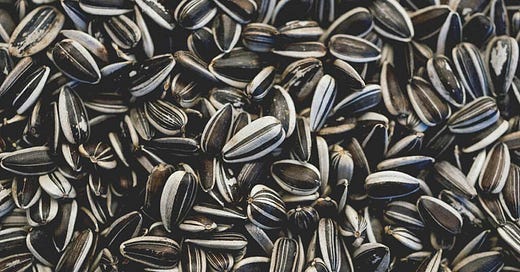Sunflower Seeds
Because sunflowers are a global crop that hailed from North America, it has always had a fair amount of botanical attention paid to it. They are showy, not too difficult to grow, and popular with neighborhood birds. Its commercialization in the United States took place in the 1880s and 1890s, with Missouri and Illinois leading the way in crop cultivation. For the longest time the culinary and industrial applications of the plant were singularly unimaginative: seeds pressed for oil or roasted for snacks, seedcake feed for livestock, foliage used as silage. Some experiments were made with transforming stalks to fiber, but none of you are wearing sunflower cloth shirts or printing documents on sunflower paper. A botanical offshoot, the Jerusalem artichoke produces edible roots that have periodically been rebranded (sunchoke is the present favorite moniker), but has never entered into the heavy rotation of consumed root vegetables.
The oil is available in several forms. The last 60 years of plant breeding have produced four profiles: High Oleic, High Linoleic, High Stearic-Oleic, and Mid-Oleic. Each has an application in mind—whether for cosmetics, frying medium, baking lipid, or salad lubricant. It is sufficiently ubiquitous not to require any special advocacy on my part. I confess my interest is how to make the seed more interesting as a food.
Roasted sunflower seed was a Native food. As the sunflower went global, certain cultures embraced it particularly. The Russians (breeders of the largest sunflowers in the 19th century), made the chew and spit roasted sunflower a hallmark of street eating. The seeds would be roasted, salted, and sold; the consumer would bite through the hull, spit the shell out, and nibble the meat. No problem with the huge seed they were producing. Indeed of the heirloom varieties now available, the mammoths (such as the Mammoth Grey) have an America to Russia to America lineage.
I have become fascinated with the hulled meats that are now available. Packets of de-hulled sunflower seeds are available in many stores. Planters offers them dry roasted. Bob’s Red Mill offers Shelled raw seeds in 20 oz packages. There are a number of suppliers. These raw seeds stimulate the culinary imagination. In the Ukraine there is a stew made of the seed meats that have been tenderized in a pressure cooker. To thicken the stew they take a portion of the pressure cooked seed and puree it in a blender. It marries well with salt and aromatics. I’ve seen American chefs borrow the idea for sunflower seed risotto. Another school of preparation employs two cooking methods: roasting or frying the seed and then boiling or pressure cooking it. To complicate the flavor, don’t use sunflower oil as your frying medium. Duck fat, coconut oil, or ghee. I’ve dry parched the seeds brown and powdered them to use as a thickener—this powdered meal has an affinity for butter. At any rate—the seed is inexpensive, relatively pliable, and can be surprisingly satisfying in a range of preparations.
I’ve never seen a systematic exploration of the various Native employments of the sunflower. The seed cakes have been discussed by numbers of commentators, but I’m sure there is a depth of composite dishes remain known only to specialists.





I love sunflower seeds. My understanding is that sunflower seed oil is a healthy oil, provided that it is cold pressed. Though, most sunflower seed oils on the market are made using chemicals solvents like hexane. These highly processed "seed oils" are said to increase the risk of colon cancer.